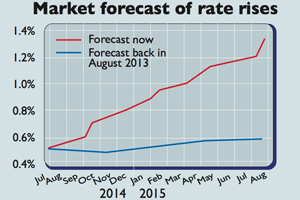
Bank of England governor Mark Carney gave investors a jolt last week by saying that interest rates could rise “sooner than markets currently expect”.
In response, interest-rate expectations soared, with the first rise from the current record low of 0.5% now pencilled in for late 2014, compared to the previous estimate of April 2015.
Trade-weighted sterling, measured against a basket of major trading partners’ currencies, jumped to a new post-crisis high.
“For all the headlines and histrionics,” says Liam Halligan in The Sunday Telegraph, there was more to the speech than the half-sentence that caused the “frenzy of speculation”. In fact, Carney’s remarks were “heavily qualified”.
He mentioned that the Bank’s estimate of the spare capacity in the economy – the extent to which growth can continue without sparking inflation – is 1%-1.5% of GDP.
What’s more, the bank thinks that the rate at which the economic “slack” in the system is being used up will slow in the second half of the year. All this would tend to point to a rate rise later rather than sooner.
In any case, says Halligan, investors should remember that Carney’s previous attempts at guiding market expectations have hardly been an unqualified success. His forward-guidance policy was designed to provide reassurance about the path of interest rates, but just ended up causing confusion.
Last August, the first rate rise was not expected until late 2016. Then the unemployment figures improved so fast they fell below the threshold of 7% that was supposed to be reached before rates could rise. The target was ditched. Now he appears to have updated his outlook again.
The upshot? We don’t know when rates will rise; we merely know, given our huge debt load, that they are likely to impose “serious pain”.
Carney’s “forecasting abilities make Michael Fish look bang on”, as Alistair Osborne puts it in The Times. But he’s “in good company”. Four months before the subprime disaster exploded, for instance, former US Federal Reserve chairman Ben Bernanke said subprime problems were likely to be contained. Given that, it’s mystifying that markets still seem to hang on central bankers’ every word.
Former Fed chairman Alan Greenspan admitted last year that “we really can’t forecast all that well, and yet we pretend we can, but we really can’t”. That, as Osborne concludes, is the “truest thing he ever said”.